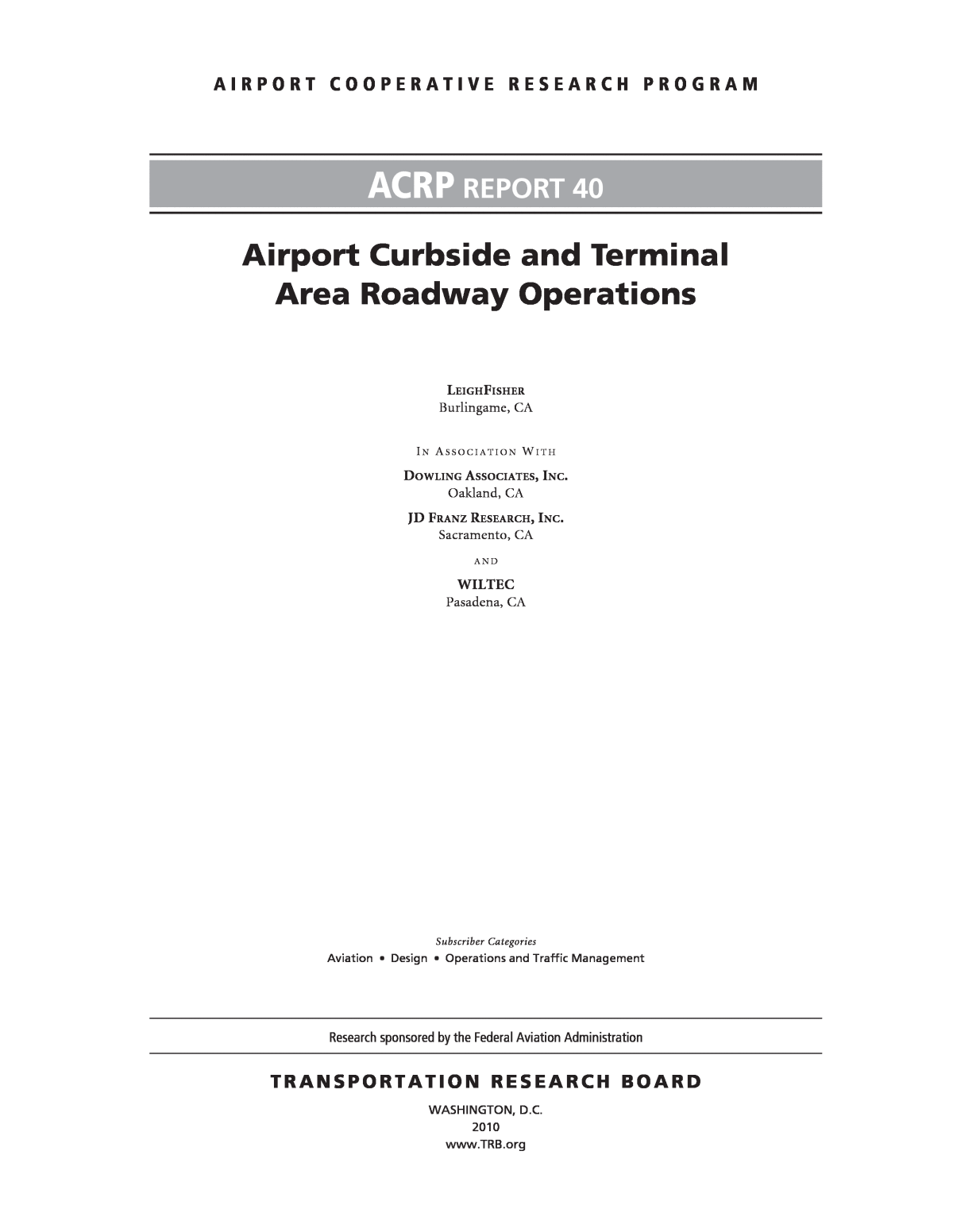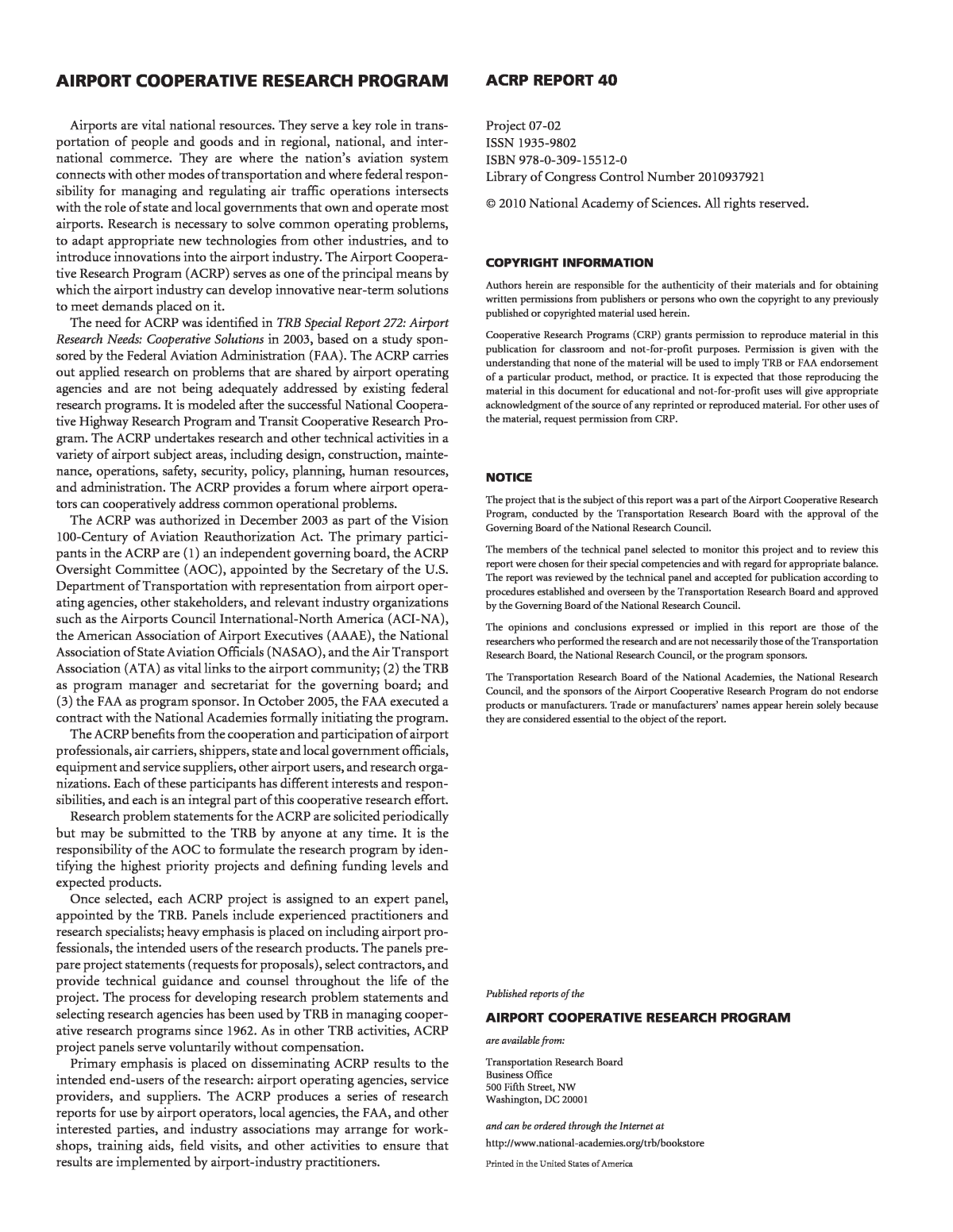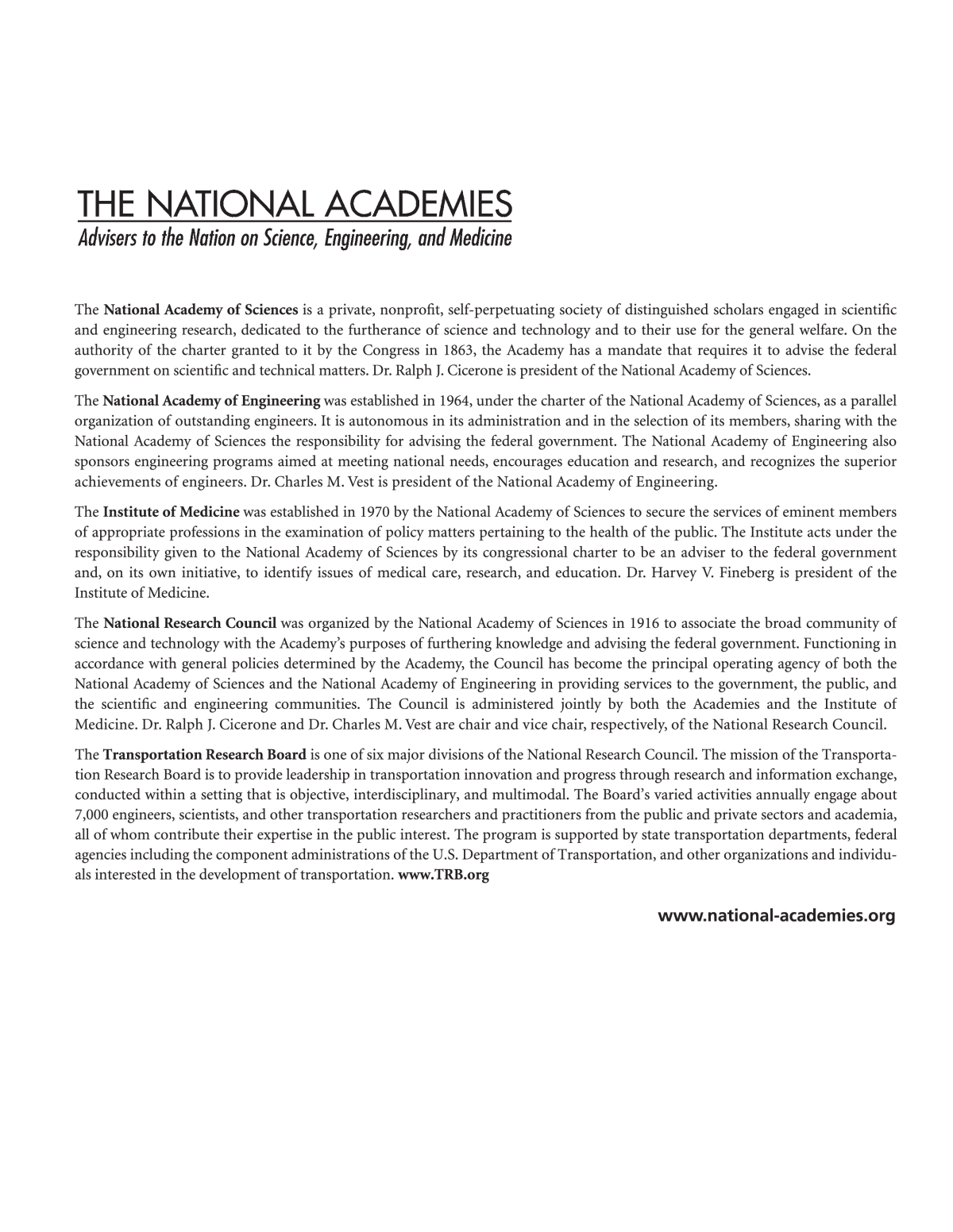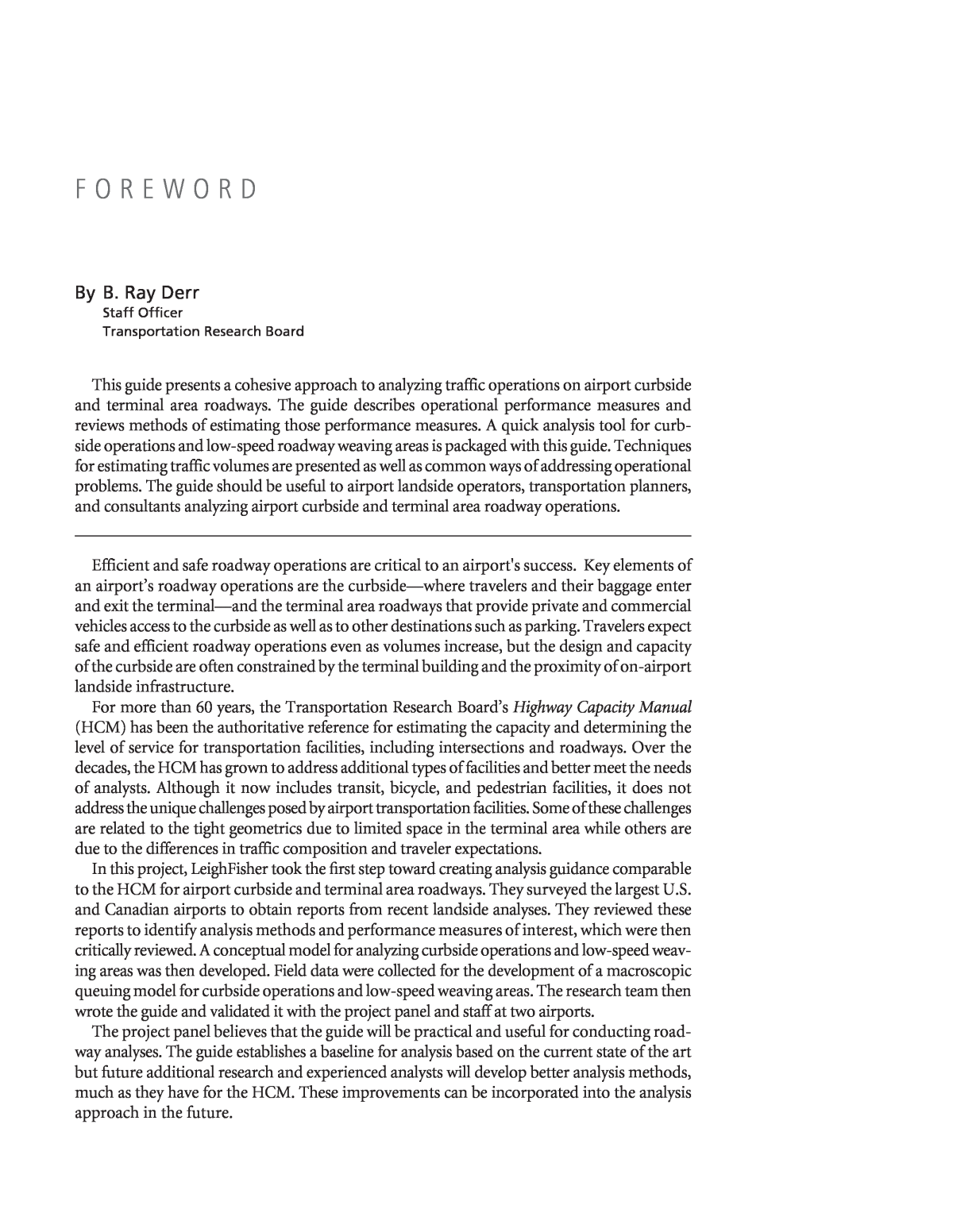






Below is the uncorrected machine-read text of this chapter, intended to provide our own search engines and external engines with highly rich, chapter-representative searchable text of each book. Because it is UNCORRECTED material, please consider the following text as a useful but insufficient proxy for the authoritative book pages.
TRANSPORTAT ION RESEARCH BOARD WASHINGTON, D.C. 2010 www.TRB.org A I R P O R T C O O P E R A T I V E R E S E A R C H P R O G R A M ACRP REPORT 40 Research sponsored by the Federal Aviation Administration Subscriber Categories Aviation ⢠Design ⢠Operations and Traffic Management Airport Curbside and Terminal Area Roadway Operations LEIGHFISHER Burlingame, CA I N A S S O C I A T I O N W I T H DOWLING ASSOCIATES, INC. Oakland, CA JD FRANZ RESEARCH, INC. Sacramento, CA A N D WILTEC Pasadena, CA
AIRPORT COOPERATIVE RESEARCH PROGRAM Airports are vital national resources. They serve a key role in trans- portation of people and goods and in regional, national, and inter- national commerce. They are where the nationâs aviation system connects with other modes of transportation and where federal respon- sibility for managing and regulating air traffic operations intersects with the role of state and local governments that own and operate most airports. Research is necessary to solve common operating problems, to adapt appropriate new technologies from other industries, and to introduce innovations into the airport industry. The Airport Coopera- tive Research Program (ACRP) serves as one of the principal means by which the airport industry can develop innovative near-term solutions to meet demands placed on it. The need for ACRP was identified in TRB Special Report 272: Airport Research Needs: Cooperative Solutions in 2003, based on a study spon- sored by the Federal Aviation Administration (FAA). The ACRP carries out applied research on problems that are shared by airport operating agencies and are not being adequately addressed by existing federal research programs. It is modeled after the successful National Coopera- tive Highway Research Program and Transit Cooperative Research Pro- gram. The ACRP undertakes research and other technical activities in a variety of airport subject areas, including design, construction, mainte- nance, operations, safety, security, policy, planning, human resources, and administration. The ACRP provides a forum where airport opera- tors can cooperatively address common operational problems. The ACRP was authorized in December 2003 as part of the Vision 100-Century of Aviation Reauthorization Act. The primary partici- pants in the ACRP are (1) an independent governing board, the ACRP Oversight Committee (AOC), appointed by the Secretary of the U.S. Department of Transportation with representation from airport oper- ating agencies, other stakeholders, and relevant industry organizations such as the Airports Council International-North America (ACI-NA), the American Association of Airport Executives (AAAE), the National Association of State Aviation Officials (NASAO), and the Air Transport Association (ATA) as vital links to the airport community; (2) the TRB as program manager and secretariat for the governing board; and (3) the FAA as program sponsor. In October 2005, the FAA executed a contract with the National Academies formally initiating the program. The ACRP benefits from the cooperation and participation of airport professionals, air carriers, shippers, state and local government officials, equipment and service suppliers, other airport users, and research orga- nizations. Each of these participants has different interests and respon- sibilities, and each is an integral part of this cooperative research effort. Research problem statements for the ACRP are solicited periodically but may be submitted to the TRB by anyone at any time. It is the responsibility of the AOC to formulate the research program by iden- tifying the highest priority projects and defining funding levels and expected products. Once selected, each ACRP project is assigned to an expert panel, appointed by the TRB. Panels include experienced practitioners and research specialists; heavy emphasis is placed on including airport pro- fessionals, the intended users of the research products. The panels pre- pare project statements (requests for proposals), select contractors, and provide technical guidance and counsel throughout the life of the project. The process for developing research problem statements and selecting research agencies has been used by TRB in managing cooper- ative research programs since 1962. As in other TRB activities, ACRP project panels serve voluntarily without compensation. Primary emphasis is placed on disseminating ACRP results to the intended end-users of the research: airport operating agencies, service providers, and suppliers. The ACRP produces a series of research reports for use by airport operators, local agencies, the FAA, and other interested parties, and industry associations may arrange for work- shops, training aids, field visits, and other activities to ensure that results are implemented by airport-industry practitioners. ACRP REPORT 40 Project 07-02 ISSN 1935-9802 ISBN 978-0-309-15512-0 Library of Congress Control Number 2010937921 © 2010 National Academy of Sciences. All rights reserved. COPYRIGHT INFORMATION Authors herein are responsible for the authenticity of their materials and for obtaining written permissions from publishers or persons who own the copyright to any previously published or copyrighted material used herein. Cooperative Research Programs (CRP) grants permission to reproduce material in this publication for classroom and not-for-profit purposes. Permission is given with the understanding that none of the material will be used to imply TRB or FAA endorsement of a particular product, method, or practice. It is expected that those reproducing the material in this document for educational and not-for-profit uses will give appropriate acknowledgment of the source of any reprinted or reproduced material. For other uses of the material, request permission from CRP. NOTICE The project that is the subject of this report was a part of the Airport Cooperative Research Program, conducted by the Transportation Research Board with the approval of the Governing Board of the National Research Council. The members of the technical panel selected to monitor this project and to review this report were chosen for their special competencies and with regard for appropriate balance. The report was reviewed by the technical panel and accepted for publication according to procedures established and overseen by the Transportation Research Board and approved by the Governing Board of the National Research Council. The opinions and conclusions expressed or implied in this report are those of the researchers who performed the research and are not necessarily those of the Transportation Research Board, the National Research Council, or the program sponsors. The Transportation Research Board of the National Academies, the National Research Council, and the sponsors of the Airport Cooperative Research Program do not endorse products or manufacturers. Trade or manufacturersâ names appear herein solely because they are considered essential to the object of the report. Published reports of the AIRPORT COOPERATIVE RESEARCH PROGRAM are available from: Transportation Research Board Business Office 500 Fifth Street, NW Washington, DC 20001 and can be ordered through the Internet at http://www.national-academies.org/trb/bookstore Printed in the United States of America
CRP STAFF FOR ACRP REPORT 40 Christopher W. Jenks, Director, Cooperative Research Programs Crawford F. Jencks, Deputy Director, Cooperative Research Programs Michael R. Salamone, ACRP Manager B. Ray Derr, Senior Program Officer Emily R. Greenwood, Senior Program Assistant Eileen P. Delaney, Director of Publications Hilary Freer, Senior Editor Doug English, Editor ACRP PROJECT 07-02 PANEL Field of Design Craig Leiner, Massachusetts Port Authority, East Boston, MA (Chair) Owen P. Curtis, HNTB Corporation, Arlington, VA Nathalie Martel, AECOM, Montreal, QC Scott S. Washburn, University of Florida, Gainesville, FL Kum L. âDanâ Wong, American Planning Association, San Francisco, CA Chris Hugunin, FAA Liaison Richard A. Cunard, TRB Liaison AUTHOR ACKNOWLEDGMENTS The research discussed in this report was conducted under ACRP Project 07-02, âAirport Curbside and Terminal Area Roadway Operations,â by a research team of recognized experts in airport planning and operations, traffic engineering, and transportation planning. LeighFisher (formerly Jacobs Consultancy) was the prime consultant. Peter B. Mandle, LeighFisher Director, was the Principal Investigator and W. Gavin R. Duncan, LeighFisher Principal Consultant, was the Deputy Principal Investigator. Other con- tributors from LeighFisher included Andrew Blaisdell, Dan Barton, and Tyler Tate, Consultants; and Mark Nagle, Principal Consultant. Dowling Associates was the primary subconsultant and led the research con- cerning roadway weaving analyses under the direction of Rick Dowling, President, and Marty Beene, Vice President. Senanu Ashiabor, a Dowling Associates Associate Engineer, also contributed. The focus groups of airline passengers were conducted by Jennifer D. Franz, President of JD Franz Research, Inc. The traf- fic surveys at Oakland, San Francisco, and Washington Dulles international airports were conducted by WILTEC under the direction of Moses Wilson, President. Faith Oiwa of LeighFisher coordinated the internal production and word processing of this report. Debra L. Lubin served as the technical editor. The research team would like to express its gratitude to the members of the Project Panel for their sup- port and insightful comments and advice throughout this research project. The research team would also like to thank the many airport staff members and consultants who took the time to review interim drafts of the Guide and provide their thoughts and comments. These reviewers included Foster de la Houassaye of Kimley-Horn Associates, Inc., and Joel Marcuson of Jacobs Engineering, both of whom served as sub- contractors; John Bergener of the City and County of San Francisco (San Francisco International Airport); Michael Hackett of the Metropolitan Washington Airports Authority (Washington Dulles International and Reagan Washington National airports); Hugh Johnson of the Port of Oakland (Oakland International Airport); Keith B. Wilschetz of the San Diego County Regional Airport Authority (San Diego International Airport); James W. Green of AECOM; and M. Allen Hoffman of Ricondo & Associates, Inc. C O O P E R A T I V E R E S E A R C H P R O G R A M S
This guide presents a cohesive approach to analyzing traffic operations on airport curbside and terminal area roadways. The guide describes operational performance measures and reviews methods of estimating those performance measures. A quick analysis tool for curb- side operations and low-speed roadway weaving areas is packaged with this guide. Techniques for estimating traffic volumes are presented as well as common ways of addressing operational problems. The guide should be useful to airport landside operators, transportation planners, and consultants analyzing airport curbside and terminal area roadway operations. Efficient and safe roadway operations are critical to an airport's success. Key elements of an airportâs roadway operations are the curbsideâwhere travelers and their baggage enter and exit the terminalâand the terminal area roadways that provide private and commercial vehicles access to the curbside as well as to other destinations such as parking. Travelers expect safe and efficient roadway operations even as volumes increase, but the design and capacity of the curbside are often constrained by the terminal building and the proximity of on-airport landside infrastructure. For more than 60 years, the Transportation Research Boardâs Highway Capacity Manual (HCM) has been the authoritative reference for estimating the capacity and determining the level of service for transportation facilities, including intersections and roadways. Over the decades, the HCM has grown to address additional types of facilities and better meet the needs of analysts. Although it now includes transit, bicycle, and pedestrian facilities, it does not address the unique challenges posed by airport transportation facilities. Some of these challenges are related to the tight geometrics due to limited space in the terminal area while others are due to the differences in traffic composition and traveler expectations. In this project, LeighFisher took the first step toward creating analysis guidance comparable to the HCM for airport curbside and terminal area roadways. They surveyed the largest U.S. and Canadian airports to obtain reports from recent landside analyses. They reviewed these reports to identify analysis methods and performance measures of interest, which were then critically reviewed. A conceptual model for analyzing curbside operations and low-speed weav- ing areas was then developed. Field data were collected for the development of a macroscopic queuing model for curbside operations and low-speed weaving areas. The research team then wrote the guide and validated it with the project panel and staff at two airports. The project panel believes that the guide will be practical and useful for conducting road- way analyses. The guide establishes a baseline for analysis based on the current state of the art but future additional research and experienced analysts will develop better analysis methods, much as they have for the HCM. These improvements can be incorporated into the analysis approach in the future. F O R E W O R D By B. Ray Derr Staff Officer Transportation Research Board
C O N T E N T S 1 Chapter 1 Purpose, Methodology, and Organization of this Guide 1 Purpose of the Guide 1 Methodology 1 Organization of the Guide 3 Chapter 2 Framework for Analysis of Airport Roadways and Curbsides 3 Users of Airport Roadways 4 Types of Airport Roadways 7 Operating Characteristics of Airport Terminal Area Roadways 13 Overview of Analytical Framework Hierarchy 14 Overview of Capacity and Level-of-Service Concepts 16 Chapter 3 Estimating Airport Roadway Traffic Volumes 16 Establishing Existing Airport Roadway Traffic Volumes 17 Estimating Future Airport Roadway Traffic VolumesâTraditional Four-Step Approach 28 Estimating Future Airport Roadway Traffic VolumesâAlternative Approach 30 Chapter 4 Analyzing Airport Terminal Area Roadways 30 Level-of-Service Definitions for Airport Terminal Area Roadways 30 Quick-Estimation Methods for Analyzing Airport Roadway Operations 32 Macroscopic Method for Analyzing Airport Roadway Weaving Areas 39 Use of Microsimulation Methods 40 Other Performance Measures 41 Chapter 5 Evaluating Airport Curbside Operations 41 Performance Measures 42 Level-of-Service Definitions for Airport Curbside Roadways 43 Estimating Airport Curbside Roadway Traffic Volumes 45 Estimating Airport Curbside Roadway Capacity and Level of Service 50 Analytical Framework Hierarchy for Airport Curbside Roadways 57 Chapter 6 Improving Airport Curbside and Terminal Area Roadway Operations 57 Typical Terminal Area Roadway Problems 60 Potential Terminal Area Roadway Improvement Measures 63 Typical Curbside Roadway Problems 64 Potential Curbside Roadway Improvement Measures Note: Many of the photographs, figures, and tables in this report have been converted from color to grayscale for printing. The electronic version of the report (posted on the Web at www.trb.org) retains the color versions.
70 Appendices 71 Appendix A Glossary
